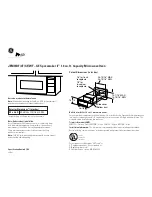
en
Tested for you in our cooking studio
46
Heating food in a microwave
Using the microwave, you can heat food, or defrost and
heat it in a single step.
Take ready-to-eat meals out of the packaging. The food
will heat up more quickly and evenly in cookware that is
suitable for microwaves. The various components of a
dish may require different times to heat up.
Food which lies flat will cook more quickly than food
which is piled high. Arrange the food as flat as possible
in the cookware for this reason. Food should not be
vertically stacked.
Cover the food. This will ensure better cooking results. If
you do not have a lid that fits your cookware, use a
plate or microwave film for this purpose.
Stir food two to three times during cooking and turn it if
necessary. After heating food up, leave it to rest for 1 to
2 minutes to compensate for the temperature
difference.
If you are heating up baby food, place the bottle onto
the wire rack without the teat or the lid. After heating up,
shake well or stir and be sure to check the temperature.
The food transfers heat to the cookware. It can become
very hot when only using the microwave for preparation.
Tip:
If you have quantities other than those indicated in
the settings table, this basic rule will help: double the
quantity equates to roughly double the cooking time.
:
Warning – Risk of scalding!
There is a possibility of delayed boiling when a liquid is
heated. This means that the liquid reaches boiling
temperature without the usual steam bubbles rising to
the surface. Even if the container only vibrates a little,
the hot liquid may suddenly boil over and spatter. When
heating, always place a spoon in the container. This will
prevent delayed boiling.
Caution!
Creation of sparks: Metal – e.g. a spoon in a glass –
must be kept at least 2 cm from the cooking
compartment walls and the inside of the door. Sparks
can irreparably damage the glass on the inside of the
door.
Recommended setting values
In the table, you can find the setting values for heating
various drinks and foodstuffs up in the microwave. The
times specified are only average values. These depend
on the cookware used, the quality, temperature and
composition of the food in question. Time ranges are
indicated. Set the shortest time first and then extend the
time if necessary.
The values in the table apply to food placed into a cold
cooking compartment.
If no values are indicated for your food, use similar
foods in the table as orientation.
Remove any accessories from the cooking
compartment which are not being used. This will ensure
optimum cooking results and will also save energy.
Wipe the cooking compartment clean after cooking.
Type of heating used:
■
Ý
Microwave
Dish
Cookware
Shelf posi-
tion
Type of
heating
MW power in
watts
Cooking
time in
mins.
Heating drinks
200 ml (stir well)
Cookware, uncovered
1
Ý
1000
1-3
400 ml (stir well)
Cookware, uncovered
1
Ý
1000
2-6
Heating baby food
Baby bottles, 150 ml (stir well)
Cookware, uncovered
1
Ý
360
1-3
Vegetables, chilled
250 g
Cookware, covered
1
Ý
600
3-8
Vegetables, frozen
loose, 250 g
Cookware, covered
1
Ý
600
8-12
Creamed spinach, frozen block, 450 g
Cookware, covered
1
Ý
600
11-16
Dishes, chilled
Plated meal, 1 portion
Cookware, covered
1
Ý
600
4-8
Soup, stew, 400 ml
Cookware, covered
1
Ý
600
5-7







































